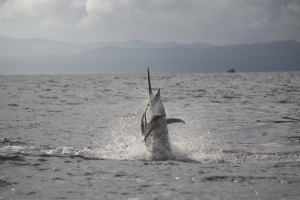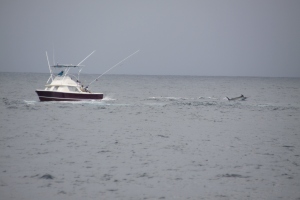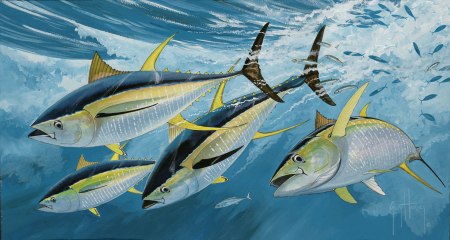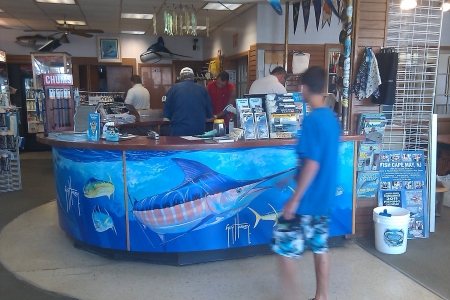“You should have been here last week – the fishing was phenomenal. We landed almost forty blacks and blues!”
By speaking those simple words, I was sure the boat captain had just cursed our fishing trip. Any angler worth their salt knows that “You should have been here last week” really means, “Sorry, nothing’s biting right now.”
This can’t be, I thought, I have guests with me – and I promised them lots of fish! Then, just as I began to contemplate the possibility that our fishing expedition might not actually involve fish, I remembered where I was – Tropic Star Lodge in Panama, a sport fisherman’s paradise and home to what is perhaps the finest – and most reliable – marlin fishing anywhere in the world.
Don’t worry, I quietly reassured myself, there will be fish, lots and lots of fish. After all, how could we miss out in a country whose name literally means “an abundance of fish”?
***************

Our trip to Panama began to take shape in October 2009, when friends Jim and Connie Elek won an auction at the annual Guy Harvey Ocean Foundation fundraiser. The prize – a fishing expedition to the legendary Tropic Star Lodge, home to more big game fishing records than any other place in the world. I have been to TSL over 40 times in the past twenty years, and I couldn’t wait to take Jim and Connie along with me on my next trip.
We planned our fishing expedition for early August to take advantage of the dark moon phase. Though it is usually rainy in Panama that time of year, we knew that August and September have traditionally been good months for hooking up big marlin, so we decided to hedge our bets on the hope that the consistent fishing of years past would win out over the rainy weather.
On our first day of fishing, we teamed up with Captain Alberto and mate Donald aboard the “Tropic Star”, one of TSL’s fifteen customized Bertram 31s. As expected this time of year, it rained most of the day and the marlin weren’t biting. However, we still managed to raise six beautiful sailfish, hooking four of them, but we didn’t get any to the boat. We also ran into some hefty dorados, but they eluded capture as well. By the end of the first day, it was Rain 1, Team Elek 0!
Ever the optimist, Connie was the first one to the dock on Day 2. Her indomitable spirit created a positive vibe among the rest of the group and set the tone for the day – even the rain left us as we departed the dock and headed to the deep waters of the Pacific. With the sun now shining, Captain Alberto soon found the bait schools on the drop off. We immediately set the baits in the water and had our first strike in less than two minutes.

In a blast of early morning spray, a 300-pound black marlin bit on the left rigger bonito and began to dance! Connie raced to the chair as the marlin went airborne time and time again, making at least twenty jumps before mate Donald grabbed the leader. Donald wired the marlin while I placed a PSAT tag in its right shoulder, which sent the great fish into another round of frenzied jumping. Finally, Donald was able to cut the leader close to the hook, and the black quickly swam away with one of Dr. Michael Domeier’s expensive tracking tags firmly attached.
After releasing Connie’s first ever marlin catch, we stayed in the area a little while longer and witnessed another black feeding on bait, but Connie’s catch was to be the only one of the day. Several other boats did well, though, catching three blacks and six blue marlin.
Day 3 began with more rain. After a couple of days fishing with the Eleks, I switched boats and fished with Jay Perez, a member of the Guy Harvey Inc. team, and his wife Dana, who were fishing on the “South Africa” with Captain Gilberto and mate Vicente. We decided to head back to the drop off where Connie landed her 300-pound black the day before. Sure enough, we found bait schools in abundance, so we set our live bait out right away.
In a scene reminiscent of the morning before, we waited only a couple of minutes before the first strike on the rigger bait. The site of the big marlin closing in sent the small bonito into a panicked jump as it tried to elude the massive attacker. It was another black, though this one was in the 500-pound range, much larger than the catch from the previous day. The huge marlin turned to catch the fleeing bonito and, with its dorsal fin and tail out of the water, violently crashed into the bait fish and swallowed it whole.
Dana was hooked up to a beast! She fought the black in heavy rain, which fell from a pink and purple sky that was illuminated by occasional streaks of lightening – a very surreal setting for the coming battle! After a long fight, the fish neared the boat and made several dramatic leaps into the air right in front of us. The struggle between fish and angler raged on for some time, and I thought the great black had finally tired out. However, as we positioned ourselves to bring the catch alongside the boat for tagging, she surprised us by diving deep and fighting hard to stay down. After 240 minutes, the line parted and the fish was gone…

***************
The big game action continued over the next couple of days, with the crew landing several large blues and blacks as well as a couple of sailfish. Then, just as the marlin fishing slowed a bit, one of the other TSL boats radioed that the tuna bite was happening a few miles west of our position. Captain Gilberto pointed the bow of the “South Africa” due west and had us on site in minutes.
We arrived to see the tuna and a pod of spotted dolphins working a large school of green jacks and rainbow chubs. I quickly threw out a 5-pound bonito, and just as I was placing the line in the clip a giant tuna attacked the baitfish and ripped the line out of my fingers. My daughter Jessica grabbed the rod and jumped into the chair. The fight was on!
Jessica worked hard on the fish, but the meager 50# line did not allow her to put much heat on the reel, making the battle last longer than it should have. However, after a ninety-minute fight, she got the tuna to the boat and Vicente grabbed the leader. The giant fish thrashed in the water, scattering the school of rainbow chubs that had been seeking shelter under the boat. Captain Gilberto and I both gaffed the fish, and it took four of us to lift it into the boat! We knew then that we had a keeper, so we decided to call it a day and make the 30-mile trek back to the lodge. At the dock, the yellowfin weighed in at 230-pounds, making it the heaviest of its kind to be landed at TSL so far this year.
(NOTE: On the previous day, junior angler Kyle Vincent landed a potential boy’s Junior IGFA yellowfin record with a 198-pound catch. Jessica still has the girl’s Junior IGFA yellowfin tuna record – also 198-pounds – caught on February 28, 2001 at Hannibal Bank near Coiba Island, Panama).
***************
The trip concluded with another strong day of fishing, which saw our boat land several more marlin, including a large blue that attacked an unused bonito that was tied off to an outrigger leg right next to the boat, and a 600-pound black that managed to wrap the leader around its bill as it went for a bonito, leaving the bait fish flying behind the marlin’s head! Just another routine day at TSL!
As it turned out, our trip wasn’t cursed. In fact, our week of fishing was every bit as good as the week before, and very likely as good as the week before that and the week before that. After all, we were in Panama, where there is always an abundance of fish.
Until next time – tight lines, good luck and, above all, fish and dive responsibly!
“GHOF Expedition: Panama 2010” Photo Album
* For more great fishing stories from Tropic Star Lodge, order a copy of my new book, “Panama Paradise: A Tribute to Tropic Star Lodge“.

Acknowledgements: Special thanks to Tropic Star Lodge for donating this trip as an auction item for last year’s 2nd Annual Guy Harvey Ocean Foundation Fundraiser. TSL is kindly donating another trip for auction at this year’s fundraiser, which will be held on October 27, 2010. Many thanks as well to Connie and Jim Elek for their support of the GHOF. The Eleks will be on hand at the fundraiser to tell about their TSL experience.
Cheers!




 Posted by guyharvey
Posted by guyharvey 











